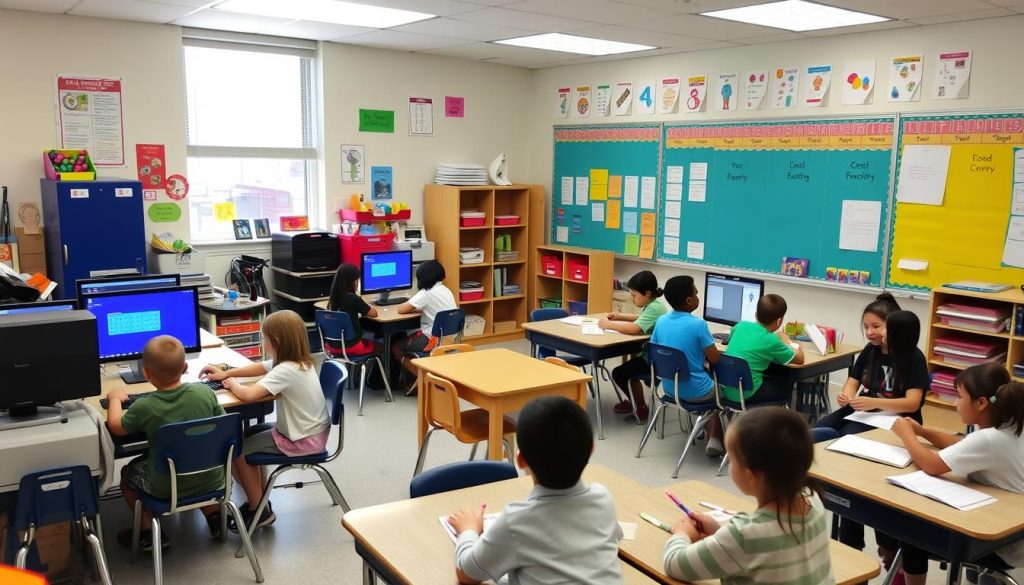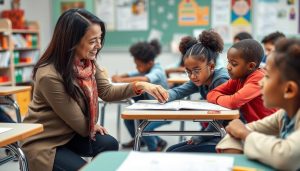As a K-12 teacher, you’re constantly seeking ways to reach every student at their level. Learning stations offer a practical solution that combines movement, engagement, and targeted instruction—all while giving you valuable time to work with small groups or individual students who need extra support.
Learning stations create opportunities for students to engage with content in different ways while teachers can provide targeted support.
Why Learning Stations Boost Differentiation
Learning stations transform the traditional one-size-fits-all approach into a dynamic environment where students can learn at their own pace and in ways that work best for them. This structure naturally supports differentiation by design.
Meeting Diverse Learning Needs
Every classroom contains students with varying abilities, learning preferences, and background knowledge. Learning stations allow you to create targeted experiences that address these differences. For example, while one group works on foundational skills, another can tackle more advanced applications of the same concept.
“When I implemented learning stations in my fifth-grade classroom, I was finally able to work intensively with my struggling readers while keeping my advanced students challenged,” shares Maria Chen, a teacher from Colorado. “The stations gave me the structure to differentiate without creating entirely separate lesson plans.”
Increasing Student Engagement
Movement matters! Research consistently shows that physical activity enhances learning. As students rotate between learning stations, they benefit from both the movement itself and the variety of activities. This approach is particularly effective for students who struggle with extended periods of sitting.
Learning stations also increase engagement by offering choice. When students have some control over their learning experience, they develop greater ownership and motivation. Even simple choices—like which station to visit first or which activity to select within a station—can significantly boost engagement.
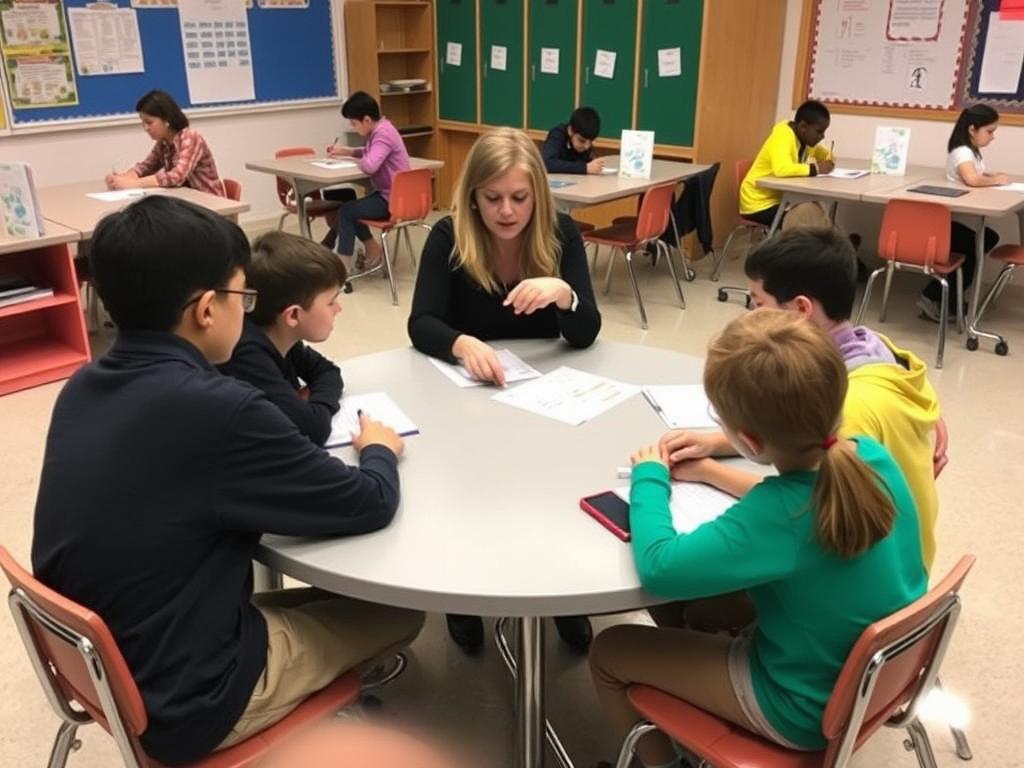
Learning stations create valuable opportunities for targeted small-group instruction.
Benefits of Learning Stations for Differentiation:
- Creates space for targeted small-group instruction
- Allows students to work at their own pace
- Provides multiple ways to engage with the same content
- Incorporates movement to enhance learning
- Builds student independence and self-management skills
- Offers natural opportunities for formative assessment
For teachers looking to deepen their understanding of differentiation strategies, comprehensive resources on differentiation techniques can provide additional insights on how to maximize the effectiveness of learning stations.
Designing Effective Learning Stations
Creating learning stations that truly enhance differentiation requires thoughtful planning. The most effective stations are purposefully designed with clear learning goals and appropriate scaffolding for different student needs.
Start with Clear Objectives
Before setting up your learning stations, identify what you want students to know and be able to do. Each station should have a specific purpose that connects to your overall learning goals. This clarity helps both you and your students understand the “why” behind each activity.
For example, if your class is studying fractions, you might create stations focused on different skills:
- Visual representation of fractions using manipulatives
- Comparing and ordering fractions
- Equivalent fractions exploration
- Real-world fraction problem solving
- Teacher-led instruction for challenging concepts
Consider Your Space
You don’t need a massive classroom to implement learning stations effectively. Even in smaller spaces, strategic furniture arrangement can create distinct areas for different activities. Consider using:
- Desk clusters for collaborative work
- Floor spaces with pillows for reading
- Wall space for standing activities
- Hallway areas (if permitted) for extension activities
- Digital stations that require minimal physical space
The key is creating clear visual and physical boundaries between stations so students understand where each activity takes place. Thoughtful arrangement of classroom space creates distinct learning zones for different activities.
Differentiate Within Each Station
The real power of learning stations comes from building differentiation into each one. Here are strategies to ensure your stations accommodate diverse learners:
Tiered Activities
Create multiple entry points for the same concept. For example, in a writing station, provide sentence starters for students who need support, while offering extension prompts for advanced writers.
Choice Boards
Give students options within each station. A choice board might offer different ways to demonstrate understanding—through writing, drawing, speaking, or creating.
Flexible Resources
Include resources that support different learning preferences, such as visual aids, audio options, and hands-on materials.
“The most successful learning stations I’ve created don’t just separate students physically—they offer meaningful differentiation within each station. This way, students working side by side might be engaging with the same concept but at their appropriate challenge level.”
— James Wilson, 3rd Grade Teacher
For more ideas on creating differentiated activities for your learning stations, explore these research-based differentiation strategies that can be adapted for various grade levels and subjects.
Implementing Learning Stations in Your Classroom
Even the best-designed learning stations won’t succeed without thoughtful implementation. Creating clear routines and expectations is essential for smooth transitions and productive work time.
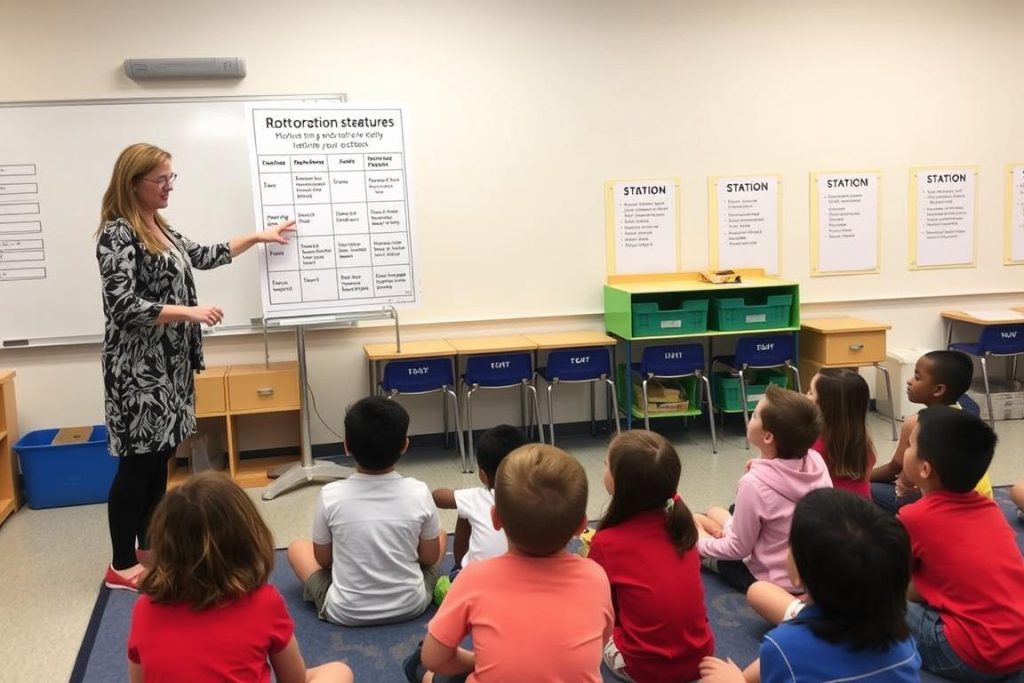
Clear demonstration of procedures helps students understand learning station expectations.
Establishing Routines
Strong routines are the foundation of successful learning stations. Take time to teach and practice these routines before expecting students to work independently.
How do I introduce learning stations to my class?
Start small with just two stations—one teacher-led and one independent. Model expectations explicitly, then gradually add more stations as students demonstrate readiness. Consider using a “fishbowl” approach where one group demonstrates while others observe.
How long should students spend at each station?
Station duration depends on your students’ age and attention spans. For younger students (K-2), 10-15 minutes per station is often appropriate. Older students might engage productively for 15-20 minutes. Use a visible timer so students can monitor their time.
How do I manage transitions between stations?
Create a consistent signal for transitions (chime, music, lights) and practice moving between stations efficiently. Use visual cues like numbered stations or color coding to direct traffic flow. Some teachers find it helpful to stagger transitions so not all groups move simultaneously.
Managing Independent Work
For learning stations to be effective, students need to work productively without constant supervision. These strategies help build independence:
Clear Instructions
Provide written or visual instructions at each station. For younger students, use pictures alongside text. For older students, include examples of what successful work looks like.
Consider creating task cards or recording short video instructions that students can reference independently when they get stuck.
“Ask Three Before Me”
Teach students to seek help from peers before approaching you, especially when you’re working with a small group. This builds collaboration and problem-solving skills while preserving your time for targeted instruction.
Designate “expert” students who can serve as resources for specific stations, giving them leadership opportunities while supporting their classmates.
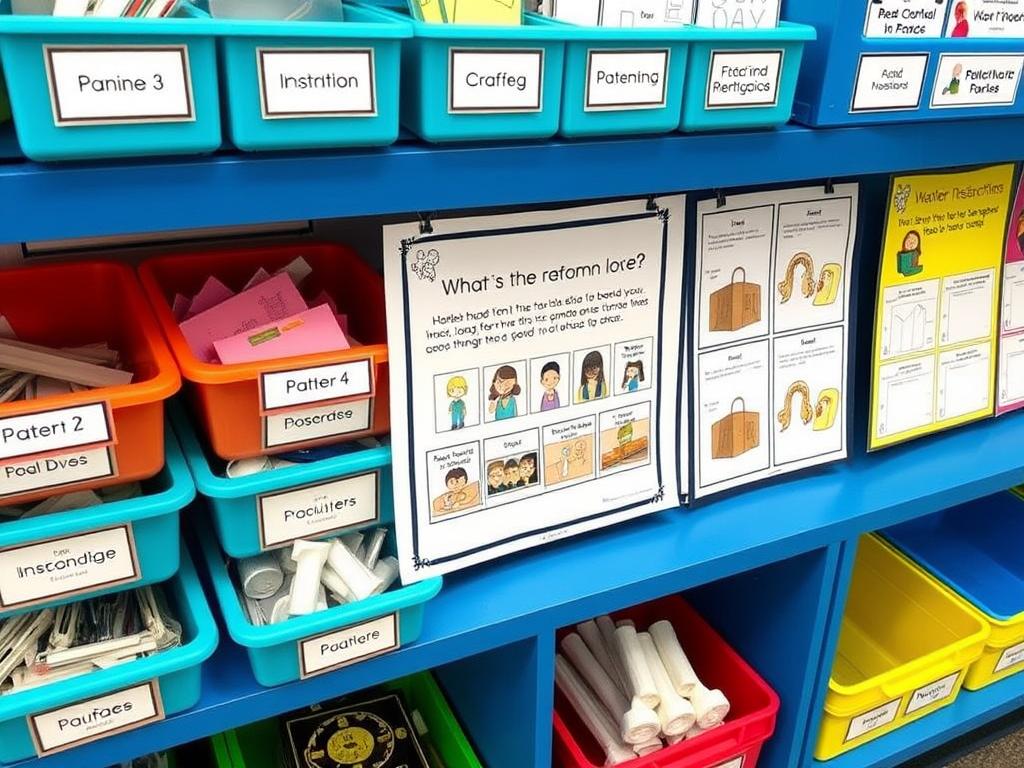
Clear visual instructions help students work independently at learning stations.
Pro Tip: The “Stuck” Strategy
Teach students what to do when they get stuck using this simple framework:
- Reread/review the instructions
- Look at examples or resources provided
- Ask a classmate at your station
- Move to the “waiting space” near the teacher station
- Work on the “While You Wait” activity until the teacher is available
For more classroom management strategies specifically designed for differentiated learning environments, check out these teacher-tested resources from Credits for Teachers.
Learning Stations Rotation Models That Work
There’s no one-size-fits-all approach to implementing learning stations. Different rotation models offer flexibility to meet your instructional goals and classroom constraints.

Well-planned rotation systems help students transition smoothly between learning stations.
Common Rotation Models
Traditional Rotation
All groups move to a new station at the same time based on a timer. This works well when activities take approximately the same amount of time to complete.
Best for: Well-established routines, activities of similar length
Flexible Rotation
Students move to the next station when they complete their current task. This accommodates different work paces but requires clear procedures for transitions.
Best for: Mixed-ability groups, activities that may take varying amounts of time
Choice-Based Rotation
Students choose which stations to visit (with some parameters). This increases engagement through autonomy but requires monitoring to ensure balanced participation.
Best for: Older students, building independence, review activities
Sample Station Configurations
The number and type of stations you implement will depend on your instructional goals, class size, and available resources. Here are some proven configurations:
| Configuration | Description | Benefits |
| Three-Station Model | • Teacher-led small group • Collaborative practice • Independent work | Simple to manage; ensures each student receives small-group instruction daily |
| Four-Station Model | • Teacher-led instruction • Digital/technology practice • Hands-on application • Independent reading/writing | Incorporates multiple modalities; balances screen time with other activities |
| Subject-Based Stations | • Reading station • Writing station • Math station • Science/Social Studies station | Covers multiple subjects in one block; works well for elementary classrooms |
| Skill-Based Stations | Stations focused on different skills within the same subject (e.g., for reading: fluency, comprehension, vocabulary, writing response) | Targets specific skills; allows for precise differentiation |
“I found that starting with just three stations was manageable for both me and my students. As we became more comfortable with the routines, I gradually added more options. The key was making sure each station had a clear purpose tied to our learning goals.”
— Rebecca Sanchez, 4th Grade Teacher
For detailed guidance on implementing various station rotation models, explore the strategies for improving small-group instruction from Edutopia.
Integrating Technology into Learning Stations
Technology can enhance learning stations by providing additional differentiation opportunities, immediate feedback, and engaging interactive experiences. When thoughtfully integrated, digital tools become powerful components of your station rotation model.
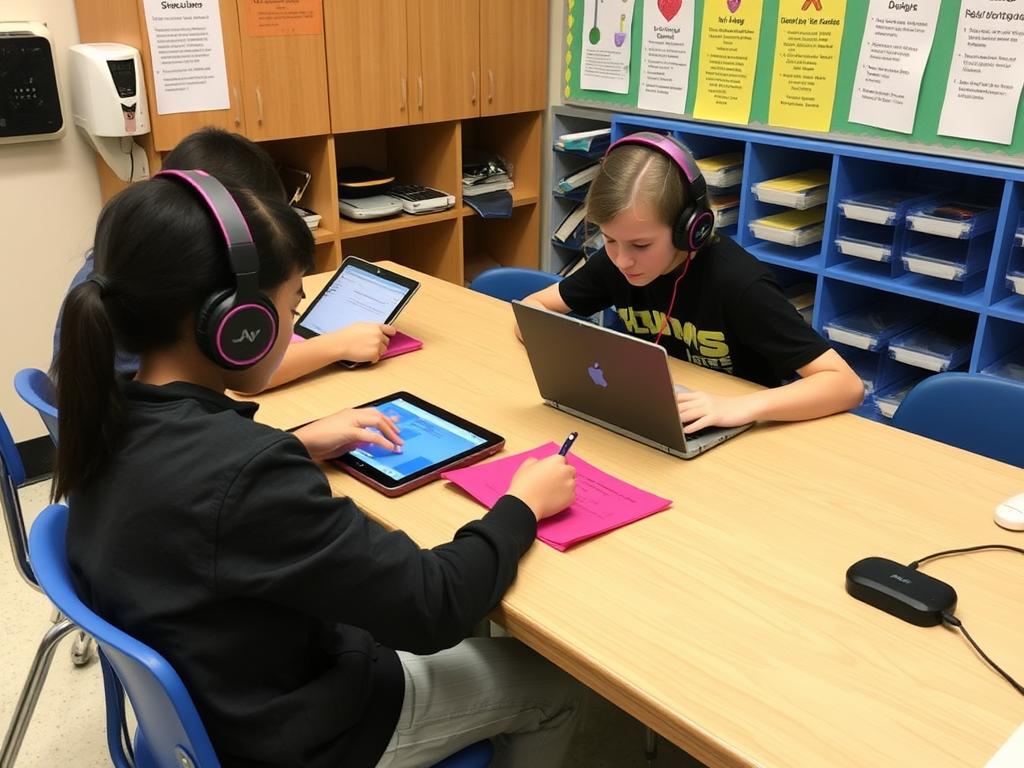
Technology stations allow for personalized learning paths and immediate feedback.
Effective Digital Station Ideas
Adaptive Learning Programs
Platforms that adjust to student performance provide built-in differentiation. As students work, the program automatically increases or decreases difficulty based on their responses.
Consider setting up a digital station where students can access personalized learning paths through programs that target specific skills they need to develop.
Creation and Collaboration Tools
Digital tools that allow students to create content or collaborate with peers can transform passive learning into active engagement.
Set up stations where students use digital tools to create presentations, record explanations, design infographics, or collaborate on shared documents related to your current unit of study.
Technology Station Tips
- Have a non-digital backup plan ready for technology failures
- Create clear procedures for device handling and troubleshooting
- Use headphones to manage noise levels
- Consider screen time balance across your station rotation
- Preview all digital content before assigning to students
Remember that technology should enhance learning, not just digitize traditional worksheets. Look for applications that offer experiences that wouldn’t be possible without technology, such as virtual field trips, interactive simulations, or global collaborations.
Assessment Strategies for Learning Stations
Learning stations create natural opportunities for ongoing assessment. As students work in small groups or independently, you can gather valuable data about their progress and adjust instruction accordingly.
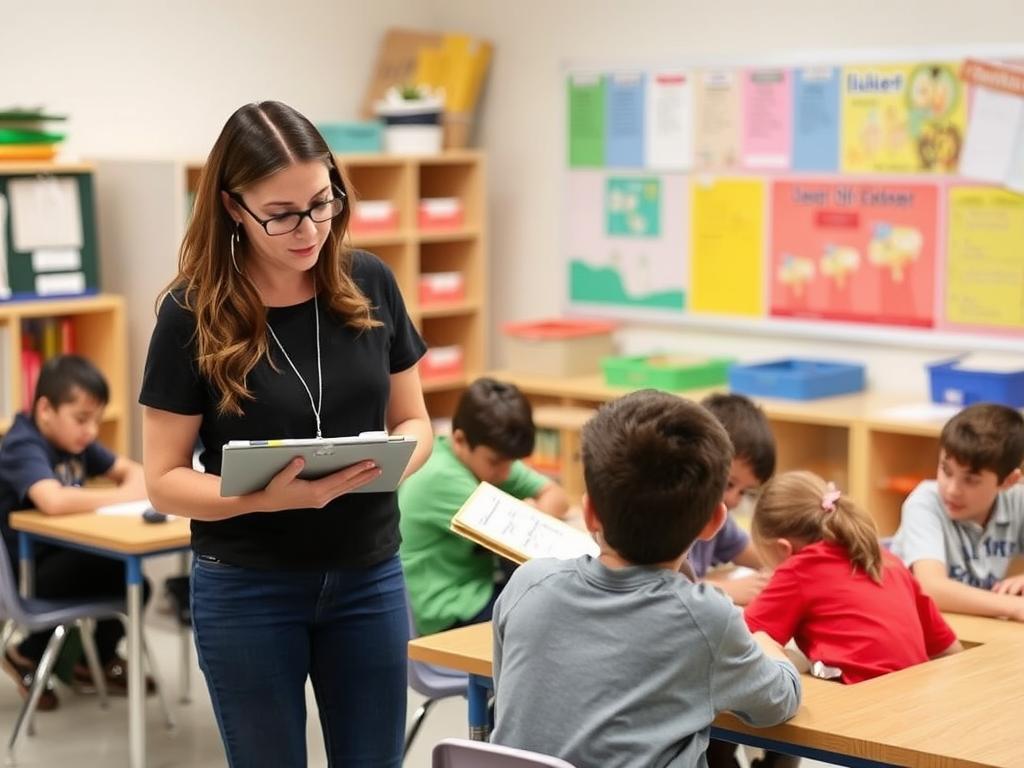
Learning stations provide valuable opportunities for authentic assessment through observation.
Formative Assessment Techniques
Incorporate these assessment strategies into your learning stations routine:
Observation Notes
Create a simple template to record observations as students work. Focus on specific skills or behaviors aligned with your learning targets. Use color coding or symbols for quick documentation.
Exit Tickets
Include a brief assessment task at each station that students complete before transitioning. These provide immediate feedback on understanding and help you plan future instruction.
Student Self-Assessment
Encourage metacognition by having students reflect on their learning. Simple prompts like “I learned…” “I wonder…” and “I need help with…” build self-awareness.
Managing the Data
With multiple stations generating assessment information, you need efficient systems to organize and use this data:
- Create digital or physical folders for each student to collect work samples over time
- Use a simple tracking system to record which stations students have completed
- Schedule regular time to review assessment data and plan responsive instruction
- Group students flexibly based on assessment results for targeted instruction
The rich assessment data gathered through learning stations can help you make informed decisions about grouping, instruction, and intervention. For more advanced assessment strategies specifically designed for differentiated classrooms, explore these professional development resources from Credits for Teachers.
Getting Started with Learning Stations
Implementing learning stations doesn’t have to be overwhelming. Start small, be consistent, and gradually expand as your comfort level and your students’ independence grows.
Your Learning Stations Action Plan:
- Identify one subject or time block to begin implementing stations
- Start with just 2-3 stations that serve clear instructional purposes
- Explicitly teach and practice routines before expecting independence
- Gather feedback from students and adjust as needed
- Gradually add more stations or complexity as routines become established
Remember that the goal of learning stations is to enhance differentiation and engagement—not to create more work for you or your students. Focus on quality over quantity, and be patient with the implementation process.
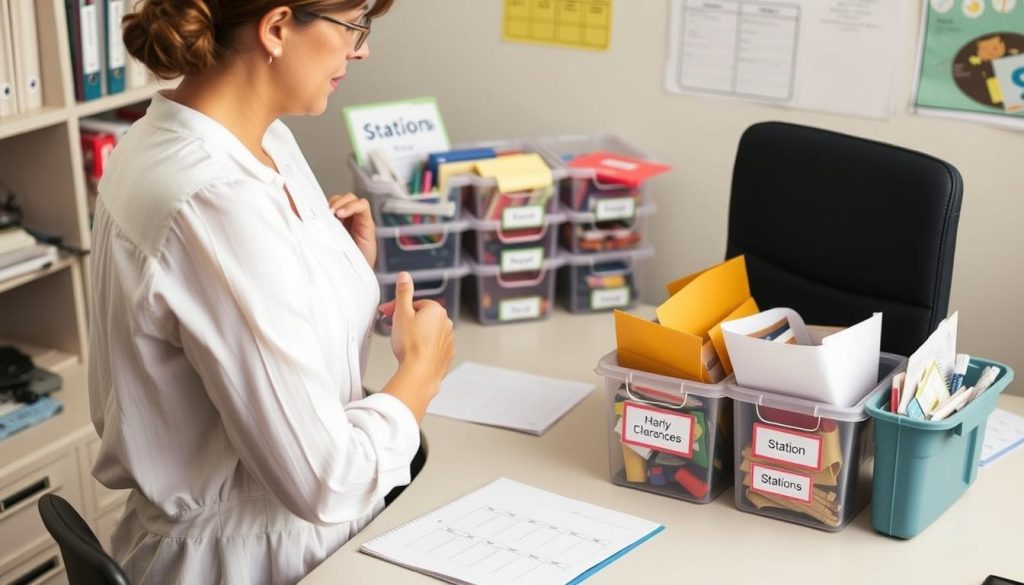
Thoughtful planning and organization are key to successful learning stations implementation.
Learning stations represent one of the most effective approaches to differentiation in today’s diverse classrooms. By creating spaces where students can engage with content in various ways, you’re acknowledging and honoring the unique learners in your care.
Ready to Take Your Differentiation to the Next Level?
Explore our comprehensive collection of differentiation resources designed specifically for K-12 teachers. From ready-to-use station activities to complete unit plans, we have everything you need to implement effective learning stations in your classroom.
For ongoing support and professional development opportunities related to differentiation and learning stations, visit Credits for Teachers to discover how you can earn professional development credits while enhancing your teaching practice.

